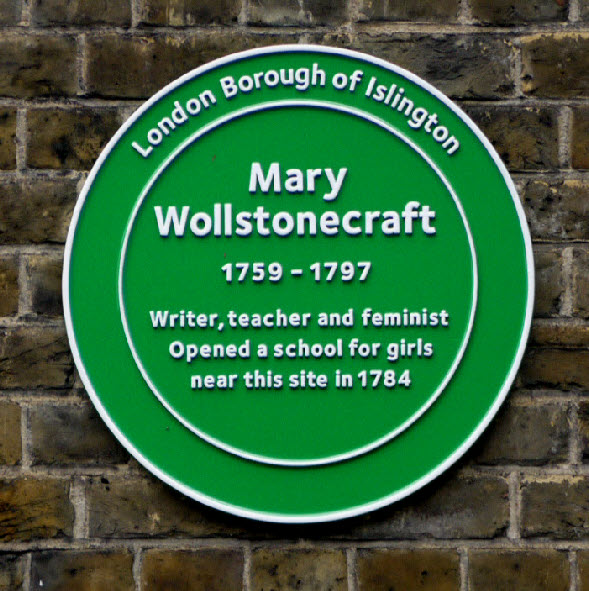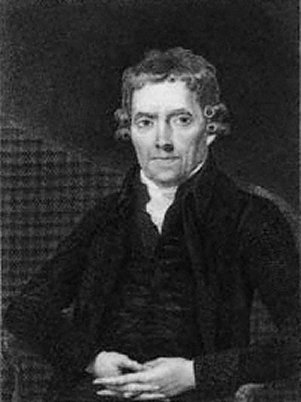Mary Wollstonecraft was an Enlightenment writer, philosopher, and reformer best known for penning The Vindication of the Rights of Women--one of the first, if not the first book on feminism. Throughout her life she petitioned for education reform for women, and was politically involved in both France and England--quite unusual for a lady of her era.
Mary was born in 1759 to Edward John Wollstonecraft and Elizabeth Dixon. Her grandfather had been a successful weaver, but her abusive father had squandered away the family fortune on his unsuccessful attempts to become a gentleman farmer. He moved his family all over England and Wales in his attempts, giving Mary a chaotic upbringing. This, combined with the way Edward bullied his wife, would later inform Mary's distaste for marriage.
When she was 19 years old Mary left home against her family's wishes to become a lady's companion to a Mrs. Dawson in the resort town of Bath. She worked for Dawson for three years before having to return home in 1781 to take care of her sick mother.
Elizabeth died in 1782, and Mary moved in with the Blood family, where she met her lifelong friend Fanny. A few years after helping her sister escape from her abusive husband, Mary, Fanny, and her sisters Eliza and Everina opened up a school in the Dissenter community in Newington Green. The Dissenters believed in combining reason with religion, which appealed to Mary.
 Mary's experiences teaching led her to write her first book Thoughts on the Education of Daughters: With Reflections on Female Conduct in the More Important Duties of Life. Mary's own education had been scattered and sporadic, but she was very well read. Her own experiences combined with the poor prior education of her students made her realized the inequality inherent in the education of boys and girls. This is a theme she would later write about in her book A Vindication of the Rights of Women.
Mary's experiences teaching led her to write her first book Thoughts on the Education of Daughters: With Reflections on Female Conduct in the More Important Duties of Life. Mary's own education had been scattered and sporadic, but she was very well read. Her own experiences combined with the poor prior education of her students made her realized the inequality inherent in the education of boys and girls. This is a theme she would later write about in her book A Vindication of the Rights of Women.
Shortly after starting their school, Fanny married, and left for Portugal. She was soon pregnant, and in early 1785, Mary boarded a ship to Portugal to care for her. Mary wasn't overly fond of Portugal, and she certainly didn't like it any better when Fanny and her daughter died in childbirth. She went back to England to find her school in shambles, and the school closed the next year.
Mary then moved to County Cork, Ireland to serve as a governess for the Kingsborough family. While the children adored her, Mrs. Kingsborough didn't, and Mary was sacked after ten months, leaving her with a distinct distaste for domestic life. Mary moved back to London, and started her life as a writer.
A year later, in 1788 Mary's publisher, Joseph Johnson, took her on as an editor and translator for his magazine Analytical Review. She was a frequent contributor of articles, but it wasn't until 1790 when she published A Vindication of the Rights of Man that she started to gain notoriety.
A Vindication of the Rights of Man was Mary's irate response to Edmund Burke's Reflections on the Revolution in France. Edmund Burke was a member of parliament who had supported the American revolution, but argued in favor of a monarchy in France. Mary, didn't like his ideas or his hypocrisy, and she published her work, first anonymously, but she put her name to it on the second printing.
Reaction literature became a common theme in Mary's life. When she wrote A Vindication of the Rights of Women in 1792, it was in resnse to Rousseau's Emile. Emile argued that a woman's role was to support the men in her life, and should be educated for that role. Education was a pet topic of Mary's, and she really let Rosseau have it. In A Vindication of the Rights of Women, Mary argued that not only are women equal to men, but that the miseducation of women caused them to be unhappy, and to inflict misery on their families and servants. This book was shocking to Georgian England, but remains a staple of feminist literature to this day.
Later that year, Mary went to France to observe and write about the Revolution. While there, she met Charles Imlay, an American writer and frontiersman. She loved him a lot more than he loved her, and though they had a child--Fanny--together, and she became his common law wife, he left her in 1795, and Mary returned to England.
In England she met William Godwin, and their affair was much happier. They married after Mary fell pregnant for the second time, this time with her daughter Mary, who would go on to write Frankenstein. Unfortunately, ten days after the birth of her second daughter, Mary Wollstonecraft died from complications with her pregnancy.
A year later William released the first biography written about Mary Wollstonecraft. Unfortunately, it was not well received. Details about Mary's personal life, her child born out of wedlock, her long term affair with Imlay and Godwin before they were married scandalized 18th century audiences, and for a long time the scandals of her life eclipsed the genius of her literary work. It wasn't until the 1900s that people began to reexamine her work, and she was accepted for the literary genius she was.
Sources
Wollstonecraft, Mary
Mary Wollstonecraft-Stanford
Mary Wollstonecraft-Biography
Mary Wollstonecraft, 1759-1797
Mary Wollstonecraft-"A Speculative and Dissenting Spirit"
Mary Wollstonecraft-Britannica
 |
| Mary Wollstonecraft |
When she was 19 years old Mary left home against her family's wishes to become a lady's companion to a Mrs. Dawson in the resort town of Bath. She worked for Dawson for three years before having to return home in 1781 to take care of her sick mother.
Elizabeth died in 1782, and Mary moved in with the Blood family, where she met her lifelong friend Fanny. A few years after helping her sister escape from her abusive husband, Mary, Fanny, and her sisters Eliza and Everina opened up a school in the Dissenter community in Newington Green. The Dissenters believed in combining reason with religion, which appealed to Mary.
 Mary's experiences teaching led her to write her first book Thoughts on the Education of Daughters: With Reflections on Female Conduct in the More Important Duties of Life. Mary's own education had been scattered and sporadic, but she was very well read. Her own experiences combined with the poor prior education of her students made her realized the inequality inherent in the education of boys and girls. This is a theme she would later write about in her book A Vindication of the Rights of Women.
Mary's experiences teaching led her to write her first book Thoughts on the Education of Daughters: With Reflections on Female Conduct in the More Important Duties of Life. Mary's own education had been scattered and sporadic, but she was very well read. Her own experiences combined with the poor prior education of her students made her realized the inequality inherent in the education of boys and girls. This is a theme she would later write about in her book A Vindication of the Rights of Women.Shortly after starting their school, Fanny married, and left for Portugal. She was soon pregnant, and in early 1785, Mary boarded a ship to Portugal to care for her. Mary wasn't overly fond of Portugal, and she certainly didn't like it any better when Fanny and her daughter died in childbirth. She went back to England to find her school in shambles, and the school closed the next year.
Mary then moved to County Cork, Ireland to serve as a governess for the Kingsborough family. While the children adored her, Mrs. Kingsborough didn't, and Mary was sacked after ten months, leaving her with a distinct distaste for domestic life. Mary moved back to London, and started her life as a writer.
 |
| Joseph Johnson |
A Vindication of the Rights of Man was Mary's irate response to Edmund Burke's Reflections on the Revolution in France. Edmund Burke was a member of parliament who had supported the American revolution, but argued in favor of a monarchy in France. Mary, didn't like his ideas or his hypocrisy, and she published her work, first anonymously, but she put her name to it on the second printing.
Reaction literature became a common theme in Mary's life. When she wrote A Vindication of the Rights of Women in 1792, it was in resnse to Rousseau's Emile. Emile argued that a woman's role was to support the men in her life, and should be educated for that role. Education was a pet topic of Mary's, and she really let Rosseau have it. In A Vindication of the Rights of Women, Mary argued that not only are women equal to men, but that the miseducation of women caused them to be unhappy, and to inflict misery on their families and servants. This book was shocking to Georgian England, but remains a staple of feminist literature to this day.
Later that year, Mary went to France to observe and write about the Revolution. While there, she met Charles Imlay, an American writer and frontiersman. She loved him a lot more than he loved her, and though they had a child--Fanny--together, and she became his common law wife, he left her in 1795, and Mary returned to England.
In England she met William Godwin, and their affair was much happier. They married after Mary fell pregnant for the second time, this time with her daughter Mary, who would go on to write Frankenstein. Unfortunately, ten days after the birth of her second daughter, Mary Wollstonecraft died from complications with her pregnancy.
A year later William released the first biography written about Mary Wollstonecraft. Unfortunately, it was not well received. Details about Mary's personal life, her child born out of wedlock, her long term affair with Imlay and Godwin before they were married scandalized 18th century audiences, and for a long time the scandals of her life eclipsed the genius of her literary work. It wasn't until the 1900s that people began to reexamine her work, and she was accepted for the literary genius she was.
Wollstonecraft, Mary
Mary Wollstonecraft-Stanford
Mary Wollstonecraft-Biography
Mary Wollstonecraft, 1759-1797
Mary Wollstonecraft-"A Speculative and Dissenting Spirit"
Mary Wollstonecraft-Britannica


No comments:
Post a Comment
Thank you so much for commenting! We have turned on comment moderation in order to cut down on the amount of spam and promotional material being sent to us. Provided your comment is not attempting to sell something, your comment will be published within the next 48 hours.